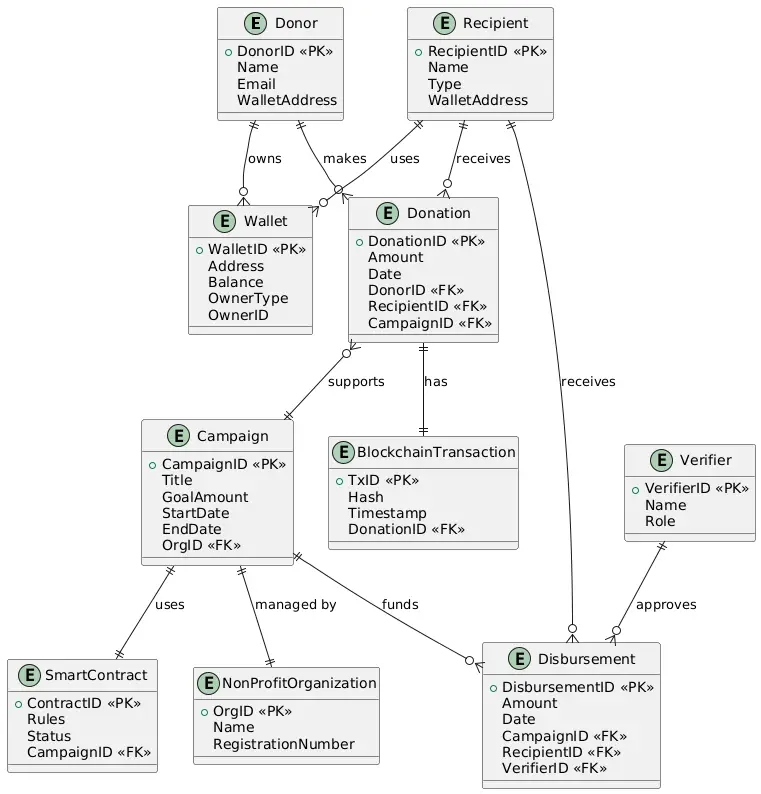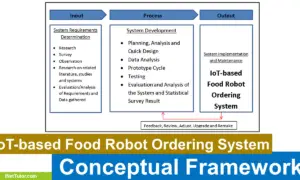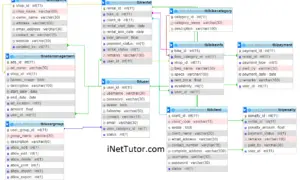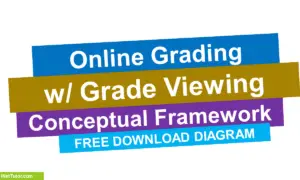Blockchain for Transparent Donations Entity Relationship Diagram
Introduction
Table of Contents
In an era where transparency and accountability are critical, blockchain technology is transforming how donations are managed and tracked. Traditional donation systems often lack visibility, leading to concerns about misuse, fraud, and inefficiencies. Blockchain introduces an immutable ledger that records each transaction, ensuring that every donor, donation, and beneficiary is accounted for. This innovation plays a vital role in reshaping how charitable contributions are managed, especially for nonprofits and humanitarian organizations.
At the heart of building a reliable donation management platform is robust data modeling. One of the most effective tools for achieving this is the Entity Relationship Diagram (ER Diagram). ER Diagrams help developers and database designers visualize the system’s data structure by mapping out entities, attributes, and the relationships between them. This visual guide lays the groundwork for implementing a scalable and efficient database.
This post is designed to help you understand how to create an ER Diagram specifically tailored for a blockchain-based transparent donation system. Whether you’re a student learning database concepts, a developer working on a capstone project, or a system analyst designing enterprise-level solutions, this guide offers clear, practical insights.
You’ll learn how to identify the core entities in the blockchain donation ecosystem, define their attributes, and map their relationships. We’ll cover every step of the ER Diagram design process and provide a full example to illustrate how the data flows from donor to recipient via secure blockchain transactions.
Our goal is to equip you with the knowledge to design your own ER Diagram for this powerful use case—one that ensures trust, integrity, and clarity in digital donations. Let’s dive in and make data work for transparency.
Overview of the Domain
Blockchain for transparent donations integrates secure digital ledgers with donation tracking systems. The domain includes several key components: donors, recipients, donations, blockchain transactions, nonprofit organizations, and verification mechanisms.
In this system, donors contribute funds or resources through a platform that records each transaction on a blockchain. These transactions are verifiable, immutable, and timestamped. Recipients—such as community projects, individuals in need, or charity campaigns—receive these donations once verified. Smart contracts help automate the release of funds based on predefined criteria.
Key processes include:
- Registration of users and organizations
- Initiating donations by donors
- Verifying transactions through blockchain nodes
- Disbursing funds to verified recipients
- Reporting and tracking donations in real-time
Managing data in this ecosystem presents several challenges:
- Data duplication due to multiple entities interacting
- Tracking relationships between donations, donors, and recipients
- Ensuring consistency in transaction records
- Maintaining data integrity across multiple distributed systems
An ER Diagram solves these problems by clearly defining each component’s role and how they interact. It establishes a solid database design before any code is written.
Imagine a small nonprofit using a blockchain platform to fund community libraries. Donors worldwide can contribute, and funds are released to local contractors only when milestones—such as building completion—are met. All activities are logged and viewable via a dashboard. This real-world scenario shows how blockchain and structured data management empower transparency and trust.
Key Concepts of ER Diagrams
Entity Relationship Diagrams (ERDs) help visualize how data elements in a system relate to each other. They are essential for designing efficient databases. Let’s break down the core components:
- Entities: These are objects or concepts that store data—like Donor, Transaction, or Campaign.
- Attributes: These define the properties of entities. For example, Donor may have Name, Email, and WalletAddress.
- Relationships: These describe how entities are connected. A Donor MAKES a Donation. A Donation GOES_TO a Recipient.
- Primary Key (PK): A unique identifier for each record in an entity.
- Foreign Key (FK): A reference to a primary key in another entity to establish a relationship.
In the blockchain donation domain:
- Donor entity stores donor details.
- Donation entity records the donation, linked to both Donor and Recipient.
- BlockchainTransaction entity logs the hash, timestamp, and related donation.
- SmartContract entity automates condition-based fund release.
Here’s a basic illustration:
Entity: Donor - DonorID <<PK>> - Name - Email - WalletAddress Entity: Donation - DonationID <<PK>> - Amount - Date - DonorID <<FK>> - RecipientID <<FK>>
The ERD links each donation to a donor and a recipient, ensuring traceability from origin to impact. This fundamental model supports real-time tracking and reporting, essential for blockchain applications.
Designing the ER Diagram for Blockchain Donations
Let’s go through the design process step-by-step:
Step 1: Identify Entities
- Donor
- Recipient
- Donation
- Campaign
- BlockchainTransaction
- SmartContract
- NonProfitOrganization
- Verifier
- Wallet
- Disbursement
Step 2: Define Attributes
- Donor: DonorID, Name, Email, WalletAddress
- Recipient: RecipientID, Name, Type, WalletAddress
- Donation: DonationID, Amount, Date, DonorID, RecipientID
- Campaign: CampaignID, Title, GoalAmount, StartDate, EndDate
- BlockchainTransaction: TxID, Hash, Timestamp, DonationID
- SmartContract: ContractID, Rules, Status
- NonProfitOrganization: OrgID, Name, RegistrationNumber
- Verifier: VerifierID, Name, Role
- Wallet: WalletID, Address, Balance
- Disbursement: DisbursementID, Amount, Date, CampaignID, RecipientID
Step 3: Establish Relationships
- Donor MAKES Donation
- Donation IS_LINKED_TO BlockchainTransaction
- Donation IS_FOR Recipient
- Donation SUPPORTS Campaign
- Campaign IS_MANAGED_BY NonProfitOrganization
- Campaign USES SmartContract
- Verifier APPROVES Disbursement
- Recipient RECEIVES Disbursement
Step 4: Specify Constraints
- Primary keys for all entities
- Foreign keys connecting Donation to Donor, Recipient, Campaign
- Many-to-many handled via junction entities if needed
- One-to-many from Donor to Donation, Campaign to Donation
This structure ensures every donation is traceable, verifiable, and transparent.
ER Diagram Example

Here’s how the full ER Diagram looks for the blockchain donation system:
Entities and Relationships:
- Donor — DonorID <>, WalletAddress
- Recipient — RecipientID <>, WalletAddress
- Donation — DonationID <>, DonorID <>, RecipientID <>, CampaignID <>
- Campaign — CampaignID <>, OrgID <>
- BlockchainTransaction — TxID <>, DonationID <>, Hash
- SmartContract — ContractID <>, CampaignID <>
- NonProfitOrganization — OrgID <>
- Verifier — VerifierID <>, Role
- Wallet — WalletID <>, Address
- Disbursement — DisbursementID <>, RecipientID <>, CampaignID <>, VerifierID <>
Visual Description:
- Each donor links to multiple donations
- Donations are tied to campaigns and recipients
- Each donation has a corresponding blockchain transaction
- Smart contracts govern campaigns
- Verifiers approve disbursements
This setup ensures all data relationships mirror real-world transparency goals.
PlantUML Script for Blockchain Donation ERD
@startuml
entity Donor {
+DonorID <<PK>>
Name
Email
WalletAddress
}
entity Recipient {
+RecipientID <<PK>>
Name
Type
WalletAddress
}
entity Donation {
+DonationID <<PK>>
Amount
Date
DonorID <<FK>>
RecipientID <<FK>>
CampaignID <<FK>>
}
entity Campaign {
+CampaignID <<PK>>
Title
GoalAmount
StartDate
EndDate
OrgID <<FK>>
}
entity BlockchainTransaction {
+TxID <<PK>>
Hash
Timestamp
DonationID <<FK>>
}
entity SmartContract {
+ContractID <<PK>>
Rules
Status
CampaignID <<FK>>
}
entity NonProfitOrganization {
+OrgID <<PK>>
Name
RegistrationNumber
}
entity Verifier {
+VerifierID <<PK>>
Name
Role
}
entity Wallet {
+WalletID <<PK>>
Address
Balance
OwnerType
OwnerID
}
entity Disbursement {
+DisbursementID <<PK>>
Amount
Date
CampaignID <<FK>>
RecipientID <<FK>>
VerifierID <<FK>>
}
Donor ||--o{ Donation : "makes"
Recipient ||--o{ Donation : "receives"
Donation ||--|| BlockchainTransaction : "has"
Donation }o--|| Campaign : "supports"
Campaign ||--|| NonProfitOrganization : "managed by"
Campaign ||--|| SmartContract : "uses"
Verifier ||--o{ Disbursement : "approves"
Recipient ||--o{ Disbursement : "receives"
Campaign ||--o{ Disbursement : "funds"
Donor ||--o{ Wallet : "owns"
Recipient ||--o{ Wallet : "uses"
@enduml
Best Practices for Blockchain Donation ERDs
- Normalize data: Avoid redundant records, especially in Donation and Transaction entities.
- Maintain scalability: Design for potential increases in donors or campaigns.
- Secure sensitive data: Mask wallet addresses and personal info in public layers.
- Use consistent naming conventions: Make your ER Diagram easy to understand.
- Avoid overcomplication: Don’t model blockchain nodes unless absolutely necessary.
Tools to use:
- Lucidchart
- Draw.io
- ERDPlus
- MySQL Workbench
Real-World Applications
Real platforms like GiveTrack and Alice.si use similar architectures. They track every donation on the blockchain, offering donors visibility into how funds are used. Nonprofits use ER Diagrams to build the underlying database, ensuring donations link clearly to campaigns and beneficiaries.
Industries using this model include:
- International NGOs
- Local charities
- Disaster relief platforms
Even governments exploring aid transparency can benefit from these database structures.
Conclusion
A blockchain-powered donation platform depends on a solid database. The ER Diagram provides the blueprint. By defining entities like donors, recipients, campaigns, and blockchain transactions, you ensure data integrity and build trust.
This post showed you how to design an ER Diagram for a transparent donation system—from concept to PlantUML code. Now it’s your turn to try it out, improve it, or build on it for your own capstone or real-world application.
Want to go deeper? Check out our next post on use case diagrams for blockchain systems.
You may visit our Facebook page for more information, inquiries, and comments. Please subscribe also to our YouTube Channel to receive free capstone projects resources and computer programming tutorials.
Hire our team to do the project.


